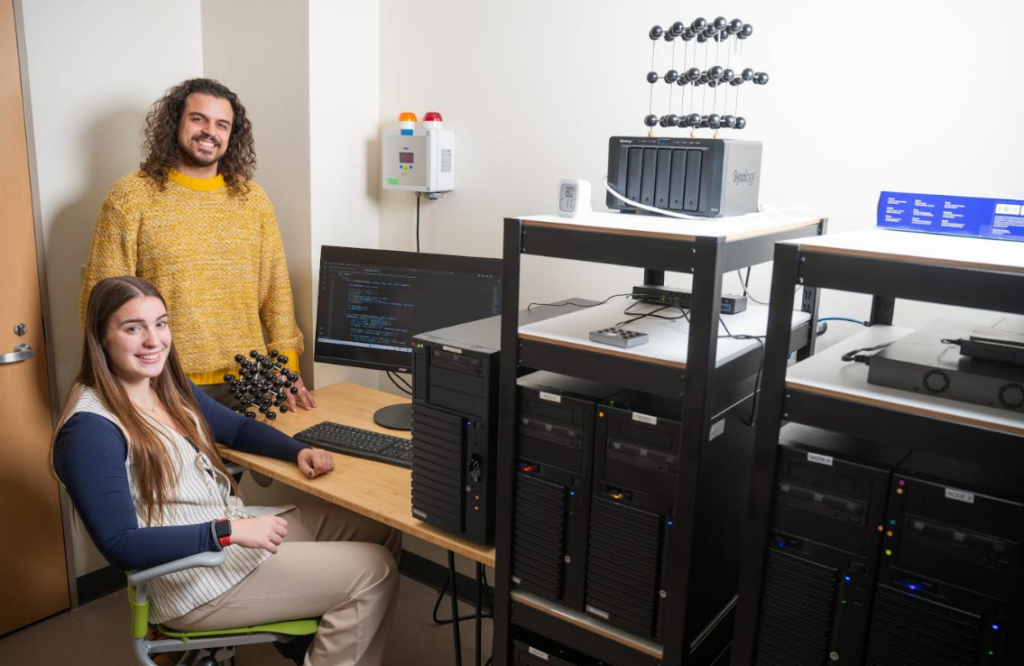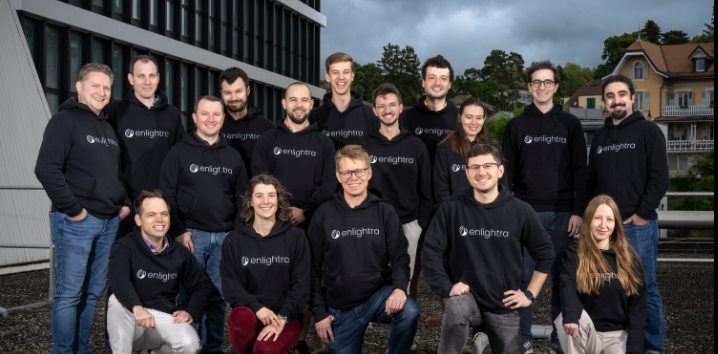Insider Brief
- A new study published in AIP Advances suggests gravity may emerge from entropy reduction in a universe behaving like a computer, rather than being a fundamental force.
- Physicist Melvin M. Vopson derives Newton’s law of gravity from information theory, proposing that matter moves to minimize information entropy, mirroring optimization routines seen in quantum computation.
- The theory reframes gravity as a computational byproduct of an entropic force acting on a discrete space, with implications for simulating gravity on quantum computers and reevaluating the universe’s informational foundations.
- Image: Dr Vopson’s thinking that gravity serves as a computational optimization process. (University of Portsmouth)
A new study argues that gravity may not be a fundamental force but an emergent property of a universe running like a computer — compressing data, conserving processing power and self-organizing toward simpler informational states. If correct, there’s a chance this reshapes how physicists approach gravity, computation, and even the architecture of spacetime.
Published in AIP Advances, the study by physicist Melvin M. Vopson at the University of Portsmouth offers a novel derivation of Newton’s law of gravitation from the principles of information theory. Rather than treating gravity as a built-in feature of the universe, Vopson reframes it as a byproduct of information entropy minimization — a kind of cosmic data compression routine. The underlying claim is that gravity is not a law to be followed, necessarily, but more like a behavior to be expected in a universe functioning like a vast computer and, because nature is quantum, more like a vast quantum computer.
“My findings in this study fit with the thought that the universe might work like a giant computer, or our reality is a simulated construct,” Vopson said in a university news article. “Just like computers try to save space and run more efficiently, the universe might be doing the same. It’s a new way to think about gravity — not just as a pull, but as something that happens when the universe is trying to stay organised.”

The Second Law of Infodynamics
At the heart of the paper is the “second law of infodynamics,” a theory Vopson previously developed to describe how information evolves in isolated systems. Unlike the second law of thermodynamics — which dictates that physical systems tend toward increasing disorder — the second law of infodynamics suggests that the entropy of informational systems decreases over time, evolving toward order and efficiency. In effect, nature trims the digital fat.
This principle forms the basis for a radical reinterpretation of gravity. Instead of being a standalone interaction, gravity emerges as the entropic pull of matter seeking to simplify what could be described as its informational footprint in space. And if the rules of information compression and minimization apply universally, they might not just govern gravity — they could point to a deeper computational substrate underlying all of physics.
While not directly addressed in the study, for researchers in quantum information science, this idea resonates with a broader shift toward seeing nature as inherently computational. Quantum computers operate on the premise of information encoded in qubits, evolving under precise constraints to reduce uncertainty. If spacetime behaves similarly, then gravity could be a visible sign of a hidden quantum algorithm at work.
Reimagining Space as a Discrete Information Grid
To ground the theory, Vopson builds a simplified two-dimensional model of space, divided into a 10-by-10 grid of elementary cells — analogous to pixels on a screen or registers in a quantum computer. Each cell can store a single bit of information, either empty (“0”) or occupied by matter (“1”). The initial entropy of the system is zero when all cells are unoccupied.
For gamers and game designers out there, this may sound familiar.
“The process is identical to how a digital computer game, virtual reality application, or other advanced simulation would be designed,” Vopson said.
The thought experiment introduces four point masses randomly placed on the grid. This increases the information entropy, since the distribution becomes less predictable. But if these particles move toward a central location and merge — forming a single, more massive object — the overall entropy drops. This self-organization, according to Vopson, is not due to an external force acting at a distance, but a natural drive to compress information.
This kind of optimization mirrors what happens in quantum computation. When running a quantum algorithm, a system of qubits evolves to reduce uncertainty and reach a low-energy, high-efficiency solution. Vopson suggests that gravity may arise from a similar informational evolution, an entropic force emerging from the universe’s attempt to store and process information with maximum efficiency.
A New Path to Newton’s Law
The study goes a step further by using this framework to derive Newton’s gravitational formula. Vopson calculates the entropic force required to shift particles toward lower entropy states, applying principles from Shannon’s information theory, thermodynamics, and the mass–energy–information (M/E/I) equivalence principle, a relationship he introduced in 2019 that links an object’s mass to the energy and information it carries.
By treating each unit of space as capable of storing a bit, and calculating how entropy changes as a particle shifts positions, the paper shows that the resulting entropic force scales precisely with mass and distance in a way that reproduces Newton’s inverse-square law of gravity. In this model, gravitational attraction is not a cause, but an outcome, a statistical behavior of a system rearranging itself to achieve computational efficiency.
The method draws heavily from information theory but doesn’t discard established physics. It accepts that objects appear to attract each other in line with classical laws but interprets this attraction as a byproduct of deeper information processing rules. In doing so, it offers a bridge between macroscopic forces and microscopic logic, potentially tying gravity to the same principles that drive quantum computation.
How It Compares to Verlinde’s Entropic Gravity
Vopson’s theory builds on — but significantly diverges from — an earlier entropic gravity hypothesis put forth by Dutch physicist Erik Verlinde in 2011. Verlinde argued that gravity results from changes in entropy on a holographic screen surrounding a mass, borrowing from the holographic principle and black hole thermodynamics. In that model, entropy increases as objects move apart, and gravity emerges as a restoring force.
But there is a difference: Vopson’s model is grounded in entropy reduction. Rather than deriving gravity from a hypothetical screen, it uses a discretized version of space and assumes the laws of information drive the rearrangement of mass. It avoids invoking emergent spacetime or extra dimensions, focusing instead on the drive toward simpler, more compressible configurations. It’s a notion with parallels in quantum error correction, where redundant information is minimized to preserve coherence.
Both approaches end up at Newton’s law, but they differ in direction and foundations. Verlinde’s model ties gravity to statistical mechanics and entropy increase. Vopson links it to computational optimization and entropy decrease. The result, he argues, is a more concrete mechanism for understanding why matter clumps together and why the universe appears to self-organize at all scales—from atoms to galaxies.
Implications for Quantum Computing and Fundamental Physics
For quantum scientists, the idea that gravity is an informational effect opens up speculative but potentially interesting avenues to explore. If gravitational behavior is just the outcome of an information system optimizing itself, then simulating gravity might be possible on quantum devices. That could happen, perhaps not by recreating spacetime geometry, but by mimicking how information entropy evolves.
This raises another speculative question: could a sufficiently large quantum computer replicate gravity by running the right algorithm? Could we model cosmological processes, galaxy formation, or even black hole dynamics as computational optimizations?
Taking, in the words of Spinal Tap guitarist one more speculative push over the cliff, if the universe itself is behaving like a quantum computational system, then quantum information — not mass or energy — might be the most fundamental currency of nature. The framework also offers new perspectives on dark matter and dark energy, which might be manifestations of information imbalances or inefficiencies in the universe’s compression routines.
And for those entertaining the “simulation hypothesis,” Vopson’s work offers another data point. A universe where gravity is an emergent data-processing artifact would be more consistent with simulation logic than with traditional field theories. While the study avoids philosophical speculation, its assumptions and results naturally lend themselves to questions about the nature of reality and whether the universe is, at root, a computation.
Limitations and the Road Ahead
Despite its elegant logic and mathematical coherence, the study remains theoretical. It lacks direct experimental validation and operates within a simplified 2D model. Future work would need to extend this to 3D, incorporate general relativity, and test whether the entropic behavior holds under complex quantum interactions or in real physical systems.
There are also conceptual questions about how this information-based force would interact with quantum fields, curved spacetime, or relativistic phenomena. And although the theory aligns with Newtonian gravity, it has yet to demonstrate compatibility with Einstein’s equations, gravitational lensing, or black hole behavior beyond entropy accounting.
That being said, Vopson’s model challenges physicists to consider whether information, not matter, is the foundation of everything — and whether gravity is merely the universe’s way of thinking more efficiently.
Ultimately, whether or not this hypothesis holds up under future scrutiny, it highlights the growing convergence between physics and information science. In a world increasingly shaped by quantum computation, the laws of nature may not just resemble code — they might be code. And gravity, long considered one of the deepest mysteries of physics, might just be a side effect of the universe keeping its files tidy.
And, for anyone who has taken a glimpse of my computer desktop or counted the number of tabs I have open, we should be all relieved I’m not in charge of the universe’s file organization.


















